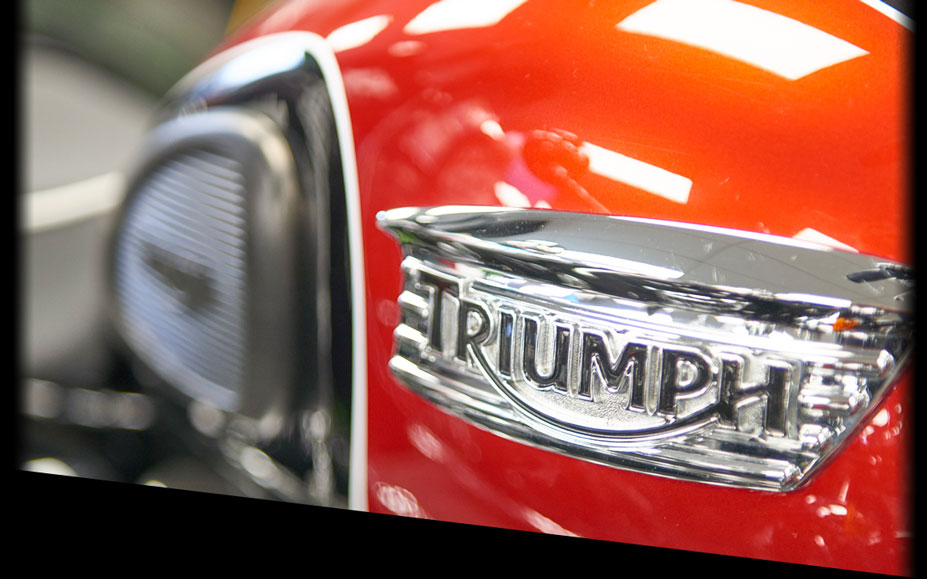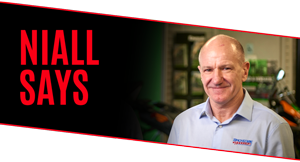
0333 0053 100

0333 0053 100


“While I was aware of the old Tridents, Bonnevilles, and Tiger Cubs, I didn’t really know too much about Triumph motorcycles as a teenager, back in the 1970s.
It was only when the Fonz jumped over some trash cans on his striking silver TR5 in the Happy Days TV show I started to pay more attention. He was all that was cool for me at the time so if Henry Winkler liked Triumphs then they would get my vote.
And I took even more interest over 10 years later, when John Bloor took over with a plan in place to put this great British manufacturer firmly back on the map. I rode 955is, Speed Triples, and 600cc Daytonas over the next decade but the Daytona 675 that arrived in 2007 was full of character. I had the use of a graphite grey 675 model for a year and loved it.
Although a full-on sports bike, I used it for everything and never tired of that three-cylinder punch and nimble handling. I’ve also had a Scrambler and an early Thruxton. These were, of course, not as fast but still delivered an engaging riding experience.
Call me weird, but my Triumph of choice is a bike I’ve never even ridden although I’m hoping that will change soon. I’ve had so many positive reports on the 765cc Street Triple RS that I feel it has to be a winner. It has their very latest three-cylinder motor, looks stunning and appears to tick every box in fun factor department. Anyone know a friendly Triumph dealer?

“I’ve had very little experience riding Triumphs as my career was mainly based around the bigger capacity bikes, while it always seemed to me that Triumph focused on the middleweight classes. It’s very exciting for the British manufacturer as they take on the Moto2 championship using their impressive 765 triple engine.
I was lucky enough to be able to test a prototype at Silverstone in 2018 and, I’m not going to lie, I was very impressed. It has a fantastically smooth power delivery that really gave you a connected feeling to the motorcycle. It filled you with confidence. All the racers I've spoken to so far say very similar things about the engine. I’m sure it’s a trait of the triple.
Finally. if you ever get a chance to check out their factory in Hinckley, you have to do it. To say I was blown away is a massive understatement. It’s very impressive and you can see why in the last five years, Triumph has gone from strength
to strength.”
To get Triumph motorbike insurance you can go through our quick and simple online form, or call us on 0333 0053 100 to speak to one of our call centre experts who can ensure you get the correct cover.
With a heritage that goes all the way back to 1902, Triumph is one of the oldest motorcycle manufacturers still in existence today.
The history of the great British marque can largely be broken down into three eras: the formative years under the ownership of Siegfried Bettmann, the famous Meriden period led by engineering boss Edward Turner and the renaissance under current owner John Bloor.
German born Bettmann had originally started out importing bicycles and, in 1888, opened up its own manufacturing site in Coventry to produce its own products. In 1902 the Triumph Cycle Company manufactured its first motorcycle, essentially a motorised bicycle powered by a 2.25bhp engine bought in from Belgian company Minerva.
Triumph played a major role in producing bikes for the allied effort during World War I, building over 30,000 bikes for the forces, including the famous Model H. Known as the ‘Trusty Triumph’ the Model H was the first Triumph to be built in significant numbers. With over 57,000 manufactured between 1915 and 1923, it was a key model in establishing the company as Britain’s leading motorcycle manufacturer.
The 1920s saw Triumph diversify into car making, while the Triumph Ricardo confirmed the company’s place as a world leader in motorcycle manufacturer. Nicknamed the ‘Riccy’ the Ricardo was named after Harry Ricardo, the famed engine builder who designed the single cylinder engine. With four-valves and 20bhp, the Riccy was a ground breaker that was capable of 70mph – even though the Model H based chassis often struggled to contain it.
Darker days were around the corner for Triumph though, and the 1930s were a tough period in the company’s history. The onset of the depression affected Triumph badly and the company was broken up over the decade. The company was bought by Ariel owner Jack Sangster, Bettmann retired and the car division was sold to Standard.
Sangster’s new company was known as the Triumph Engineering Co Ltd and with him he brought a team of brilliant engineers, most notably Val Page and Edward Turner. Turner designed a new twin-cylinder engine and the 100mph Tiger T100 was born.
As a British engineering hub, Coventry was bombed heavily in World War II. The Triumph factory was destroyed and a new facility opened in nearby Meriden, where production would continue for more than 40 years.
The post war years were commonly regarded as a golden era for the British motorcycle industry. Under the stewardship of Turner, Triumph could claim to be the leading motorcycle manufacturer in the world. Bikes like the Speed Twin and Thunderbird were at the cutting edge of performance, and the company performed well at the Isle of Man TT races and in land speed record attempts.
Their range topping model of 1959, the Bonneville T120, was named after the salt flats where Triumphs set world records. As the fastest motorcycle in the world at the time, the Bonnie quickly became a global icon.
With Japanese competition transforming the market, British manufacturers hit tough times in the 1970s. The Government forming the Norton Villiers Triumph (NVT) group to save the financially troubled companies but a lack of investment and poor industrial relations saw the downward spiral continue. In 1977 a worker’s cooperative took over Triumph but by 1983 the company was extinct.
Triumph’s assets were sold at auction, with Midlands housebuilder John Bloor purchasing the rights to the Triumph name.
Rather than simply continue building the same outdated designs, Bloor put together a team to design an all-new range of bikes bearing the Triumph name. To keep the bloodline going, he offered a licence to Devon company Racing Spares to produce Bonnevilles using the old tooling, while the new company was developed in secret.
In 1988, work began on a new factory in Hinckley, Leicestershire, and in 1991 the first new Triumphs rolled off the production line.
Based on a modular design of three and four-cylinder engines, the early Hinckley Triumphs were modern motorcycles that owed nothing other than their names to their predecessors. Under the skin, the Trident, Trophy and Daytona shared most of their components but used different bodywork and riding positions to give them all their own flavour.
Over the years, the company continued to evolve, moving away from the modular concept and building bikes that could compete with the best of the competition from around the world. In 2000 the company had a brief foray into the supersports 600 category with the flawed four-cylinder TT600, an experience that led to the Triumph refining its brand and focussing on its traditional two and three cylinder engine configurations.
The new millennium led to a revitalised model range. The company reintroduced the Bonneville, building a beautiful retro that looked just like the classic 1960s bikes, as well as the Rocket III, a 2.3 litre three-cylinder cruiser, a class leading 1050cc version of its perennial Speed Triple streetfighter and the Daytona 675.
With the Daytona, Triumph could genuinely claim to have a class leading motorcycle. It went head-to-head with the Japanese 600s using a three-cylinder design that was distinctly Triumph. From the Daytona came the smash hit Street Triple, while the Tiger 800 and 1200s muscled in on the adventure bike market dominated by BMW’s GS models.
These days Triumph makes around 60,000 bikes each year, manufactured in factories in the UK and Thailand. The current generation of retros, including a 1200cc Bonneville and the popular Bobber are taking the brand to an all-new audience, while Triumph has also inked a deal to supply 765cc Street Triple engines for use in the Moto2 Grand Prix world championships – a bold departure from a traditionally conservative brand which has shunned the racing scene in the past.